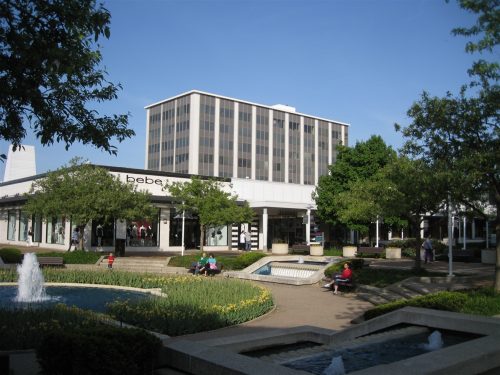Paper, Polo, Rock and Ruin
By Megan McKinney
Part Seven, Paul’s Ultimate Issue
By 1958, Paul Butler was focusing on creating the town of Oak Brook, Illinois, his vision of a Utopian village. The plan was to transform a tract of 3,000 pastoral acres–nearly half his property west of Chicago–into a polished community of three residential subdivisions and a cluster of corporate towers bordering a manicured grassy haven for rarified field sports.
The sports complex would provide an environment for the games and leisure activities classically enjoyed by members of the English upper classes and American Eastern Establishment on their country estates. Among the associations he established within the compound were the Oak Brook Polo Club, the Oak Brook Hounds, the Royal Archers Association and the Riding Club of Oak Brook.
The realization of Paul’s dream for an instant community combining recreational and residential areas with a fine office core had begun to take shape when the Illinois State Highway Commission in 1957 agreed to pay him $2 million for a five mile segment of his property through which it would construct a new East/West route. Paul with his charm, persistence and excellent connections manipulated Commission plans so the route would run north of, rather than through, his projected village to fortify a unique convergence of tollways north, south, east and west. This prompted Marshall Field & Co. to begin construction of a $25 million, 60-store shopping center on a 147 acre parcel the company had purchased two years earlier.
At the same time, Butler, with Arizona developer Del Webb, began to build the residential and commercial/industrial complex on 1,100 acres of his property. The largest portion, 8.3 square miles or 42 percent of the area, was a planned community of fine housing. Twenty-three percent would remain open space/forest land, and 13 percent was developed to accommodate 2,000 businesses, 100 of which were in the Fortune 500.
However, there were times when Paul’s visual fastidiousness collided with practicality. For example, he determined that McDonald’s could build its world headquarters in Oak Brook but none of its fast food restaurants.
Paul, then well into middle age, was a vital man with varied other interests. Aside from his standing as a four goal polo player and all-round sports participant, he was a cavalry officer and he sponsored one of the nation’s first straw hat theaters. Among the Broadway shows he backed were Kismet and the classic Mary Martin version of Peter Pan. He was also the largest single investor in The Music Man. Personally meticulous, he rose early in the morning, taking his first horseback ride around the property shortly after dawn, checking for anything that might detract from the perfection of his grounds.
Through his combined business and sports activities Paul was developing into something of a national figure. In a 1962 Sports Illustrated article, writer William Barry Furlong pointed out that although he was then 72, the Butler patriarch looked to be in his 40’s and that he was continuing to pilot jet airplanes, hunt elk and mountain lions in the Rocky Mountains, and swim outdoors one or more times daily, regardless of weather. Furlong also maintained that the Butler Company would rank, “if it were a publicly held corporation, around 400th on FORTUNE’s list of the top 500 industrial concerns in the country.” In 1972, Paul added to his sports domain the Butler National Golf Club, which was home to the Western Open from 1974 through 1990.
Paul’s estimated $100 million estate was intricate, and he left the will of a strong-minded 89 year-old man who did not expect to die. Although the document was designed to give each of his children from the marriage to Marjorie one-third of his estate, the document had not received recent updating. Michael, Frank and Jorie each received an interest in the Butler Company and the Butler National Golf Course. Additionally, Jorie inherited Paul’s homestead and the Butler Overseas Corporation, Michael received Butler Communications and Frank was left Butler Investment. There the precision ended and division was not as tidy as it might seem. Because some of the properties had been sold before Paul’s death, proper apportionment required five years during which lawyers assessed the overall value of the holdings to assure an equal share for each child.
Furthermore, without Paul’s finesse, there were significant changes in the climate surrounding the Butler relationship with Oak Brook. The patriarch’s success in forming his Utopian community had been based on relationships he had nurtured throughout almost 90 years of life in the environs of the new suburb carved from his land. Paul was a charming man, a responsible citizen and an American tycoon with statewide, and sometimes national, clout. He was also notably persistent, known as a man to whom no one could say “No” for long. Yet everyone around him was happy. He nudged, massaged, schmoozed and cajoled his way to his dream. And he had also “paid dues” to the community and all those around him, a fact his children were never able to comprehend.
Following Paul’s death, Jorie managed the family’s Oak Brook sports activities¸ including the polo operation for the first year. Then Michael stepped in, making the Oak Brook Polo Club his primary focus, while often spending money of his own in doing so. He brought in world class players, including British royals and their polo-playing circle, among them, Prince Philip, Prince Charles, the Maharaja of Jaipur and Major Ronald Ferguson, father of the Duchess of York. His polo season became a major sports and social event on the calendar internationally. Paul would have been proud of his success.
The Butlers of Oak Brook: Paper, Polo, Rock and Ruin, Megan McKinney’s series of eight articles on this remarkable dynasty, will conclude in Classic Chicago next week.
Next Sunday: But What Friends They Were!
Author Photo:
Robert F. Carl









